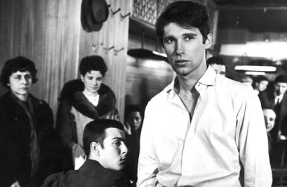The Limits of Control

About a third of the way into Med Hondo’s stunning 1979 musical West Indies ou les nègres marrons de la liberté, at which point the narrative has located itself at some unspecified time in the mid-20th century, a group of West African men and women boards a ship that will take them from the Antilles to the homeland of their French colonizers, following exhortations from a parade of French administrators, priests, social workers, and local puppet-government agents about the virtues of emigration and the joys of the metropole. Throughout these extended opening sequences, of course, Hondo has made amply clear that such coerced emigration is only intended to serve the colonial goal of disappearing the people of the islands—whether by literally removing them, or decimating the cultural and social forms that allow a people to exist in the first place. As the present-day volunteers trudge up the gangplank, another group begins to disembark from the ship: a band of captive West Africans from a previous era, bound in chains and clad in ragged clothing, being sold by an 18th-century Fulani king to the French as slaves. With this remarkable, whiplash-fast temporal fold accomplished simply by simultaneity in staging, Hondo announces his ambitious, palimpsestic project with West Indies: a condensed view of 300 years of history that, among other things, parallels the murderous forced movements of 18th-century slavery with the manipulated movements of contemporary neocolonial subjects. Beyond the intellectual point, however, Hondo also powerfully evokes that horrifying cast of mind that strips humanity from certain humans via a sudden aural break: as his camera pans over the faces of these enslaved men and women, the film’s near-constant musical score drops out and is replaced by the deeply unnerving sound of a horse grunting over and over in a crescendo of fear, effort, and pain.
This sequence contains many of the hallmarks of Hondo’s cinema: a trenchant critique of imperialism and its psychosocial devastations conveyed through striking staging, editing, and sound work; his pan-Africanist conviction that the respective postcolonial fates of African countries and the African diaspora be understood as indissolubly linked; his longstanding focus on the figure of the migrant; and his refusal of the (Western) division between the goals of art and the goals of education in the service of revealing to African audiences those histories that have been occluded by colonialism. Yet perhaps what stands out most strongly in this sequence is Hondo’s recurring focus on the movement of bodies in space, a offers one of the most powerful and moving iterations of this tendency in Hondo’s oeuvre, as the synced movements of the performers—their bodies hewing to the dictates of Western dance, the sound of cracking whips heavy on the soundtrack—give way to an explosion of revolutionary euphoria, a whirling dance of people blending together and spinning into an open, yet-to-be-made future.
You’re reading a preview, subscribe to read more.
Start your free 30 days





